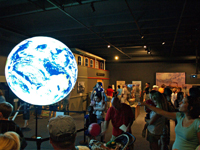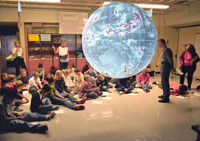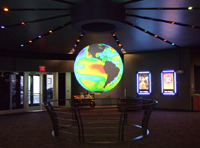NOAA Announces $1.4 Million Grants to Museums for Earth Science Exhibits
June 18, 2008

Science on a Sphere at the Thunder Bay National Marine Sanctuary in Alpena, Mich.
High resolution (Credit: NOAA)
NOAA’s Office of Education is providing funding to eight science education institutions for exhibits incorporating NOAA’s Science On a Sphere® or Magic Planet® and new Earth System Science information. These exhibits, composed of globe shaped screens that use computers and video projectors to display planetary data, give children and adults an exceptional view of our ever changing world.
“This application of NOAA expertise and data provides science centers and museums with a powerful way to teach the public about our dynamic planet,” said retired Navy Vice Admiral Conrad Lautenbacher, Ph.D., Undersecretary of Commerce for Oceans and Atmosphere and NOAA Administrator. “By using the most recent and cutting-edge data that NOAA collects these amazing exhibits will help us build environmental literacy.”

NOAA scientists explain Earth science to the students of Broomfield Heights Middle School in Broomfield, Colo., with the help of Science On a Sphere.
High resolution (Credit: NOAA)
Five awards — totaling $494,528 — provide support for the incorporation of either NOAA’s Science On a Sphere® or Global Imagination’s Magic Planet® into public exhibits showing NOAA and NASA Earth science datasets. Exhibits will be developed at the Smithsonian National Zoological Park in Washington, D.C.; the Whitaker Center for Science and the Arts in Harrisburg, Pa.; the Boonshoft Museum of Discovery in Dayton, Ohio; Oregon State University’s Hatfield Marine Science Visitor Center in Newport, Ore.; and the North Carolina Aquarium on Roanoke Island in Manteo, N.C.
Three awards — totaling $899,330 — will support partnerships to create six new modules for these spherical systems utilizing NOAA Earth science data. The groups receiving awards are: the American Museum of Natural History in New York; the University of California, Berkeley’s Lawrence Hall of Science in Berkeley, Calif.; and the Bishop Museum in Honolulu.

Science on a Sphere in the lobby of the Clark Planetarium in Salt Lake City, Utah.
High resolution (Credit: NOAA)
Each of these eight grant recipients now join NOAA's Office of Education collaborative network of more than 30 educational and scientific institutions that work to create programs to convey Earth system information to the public using these engaging and unique exhibits.
The National Oceanic and Atmospheric Administration, an agency of the U.S. Commerce Department, is dedicated to enhancing economic security and national safety through the prediction and research of weather and climate-related events and information service delivery for transportation, and by providing environmental stewardship of our nation's coastal and marine resources. Through the emerging Global Earth Observation System of Systems (GEOSS), NOAA is working with its federal partners, more than 70 countries and the European Commission to develop a global monitoring network that is as integrated as the planet it observes, predicts and protects.
